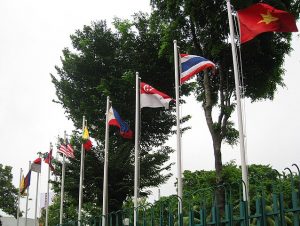Recently, Singapore hosted the latest iteration of a meeting between Southeast Asian air force chiefs. The holding of the meeting spotlighted some of the key priorities that are being advanced by officials within the service across the region amid common challenges and in spite of the issues that remain in forging greater collaboration in some areas.
As I have noted before in these pages, under the ASEAN regional grouping, Southeast Asian states have developed an ever increasing number of meetings through which they engage on the security side. One of these institutions is the ASEAN Air Chiefs Conference (AACC), which was initially established back in 2004, with the first official meeting held in Thailand. The body remains a key platform for regional air forces to discuss subjects such as military aviation and wider multilateral air force collaboration in areas ranging from counterterrorism to humanitarian assistance and disaster relief.
From August 31 to September 3, Singapore hosted the 15th iteration of the AACC as part of a series of meetings tied to its holding of the annually rotating ASEAN chairmanship this year. This iteration of the AACC was additionally significant for the city-state because 2018 also marks the 50th anniversary of the Republic of Singapore Air Force (RSAF). Apart from the regular series of consultations held between Southeast Asian officials and other side events – including golf, a cultural tour, and a gala dinner, and invitations to the RSAF50 parade for air force chiefs – this year’s AACC also saw several substantive achievements as well.
One of these, highlighted by Singapore’s defense ministry (MINDEF), was the enhancement of the ASEAN Air Forces Standard Operating Procedure for Humanitarian Assistance and Disaster Relief Operations. The original SOP had been launched and publicized at last year’s AACC, which was held in the Philippines. It is the latest in a series of measures in the ASEAN context to deepen regional collaboration in this area, which is of critical importance since Southeast Asia is among the most disaster-prone areas in the world.
Yet there was also a recognition that the SOP had to be adapted over time in order to quicken response times and foster greater collaboration. That itself constitutes a major challenge given the long series of obstacles in the Southeast Asian security setting – ranging from the different ways and means that member states operate to capacity issues among some of them. In that respect, one of the objectives that has been advanced is refining the SOP in several ways, through steps that include expediting diplomatic clearance processes. This priority has also been reflected in other previous activities during Singapore’s chairmanship, including a Command Post Exercise held earlier this year to test out the SOP and better sieve out ways to improve it moving forward.
Another notable development was the establishment of an ASEAN Air Force Counterterrorism Hotline. Terrorism was one of the first agenda items that the AACC tackled from its inception in the post-September 11 environment. And today, the counterterrorism challenge continues to be at the top of the list of concerns of Southeast Asian defense officials, including the threat of Islamic State-linked groups in Southeast Asia as concretized by the five-month siege by militants in the southern city of Marawi in the Philippines last year. Indeed, Singapore has been highlighting counterterrorism as one area of focus on the security side in its wider ASEAN chairmanship role this year as well. It has proposed a comprehensive framework of “resilience, response, and recovery” and has also drawn attention to the nexus between terrorist groups and rogue actors and chemical, biological, and radioactive weapons (CBR).
In that vein, the setting up of the hotline comes as no surprise. It is one of a series of mechanisms being adopted regionally that could play a role in further enabling greater information sharing on suspicious air activities and terrorism threats. To be sure, there are other mechanisms that are also being set up simultaneously at the bilateral and subregional levels as well as between Southeast Asian states and extraregional actors, and such hotlines can have their limits. But as the Marawi siege demonstrated, there is a dire need to better facilitate information-sharing and general collaboration between regional states.
One of the areas where discussions appear to be continuing is on the Guidelines for Air Encounters between Military Aircraft. As I have observed previously in these pages, the genesis of this idea comes from the general need to come up with confidence-building measures at sea, in the air, and even in other areas as well, with air and maritime traffic increasing and regional states modernizing their militaries. The Code for Unplanned Encounters at Sea (CUES) – a series of naval protocols for the safety of naval vessels enacted at the Western Pacific Naval Symposium back in 2014 – is a case in point, and Singapore has been among the list of countries that has attempted to broaden CUES-like measures into other domains.
In that vein, Singapore had indicated that advancing guidelines for air encounters between military aircraft would be one of several security priorities during its ASEAN chairmanship this year, following previous steps that had been adopted including agreement on forming an ad hoc working group on the initiative last year. The move would no doubt be significant as it would constitute the first multilateral implementation of confidence-building measures in this realm in the world. Singapore’s Defense Minister Ng Eng Hen had earlier expressed hope that the guidelines would be adopted at the 12th iteration of the ASEAN Defense Ministers Meeting (ADMM) in October, before it is expanded to the ADMM-Plus.
As with other ASEAN fora, agenda items will continue to be advanced in the following months under Singapore’s chairmanship and then into 2019 as well, with Thailand then taking the helm of the regional grouping. As that process continues, it will be worth watching closely what items are advanced and what new priorities may be inserted into the mix as well.
































